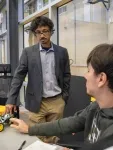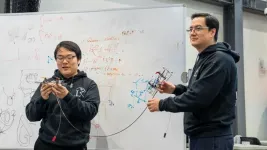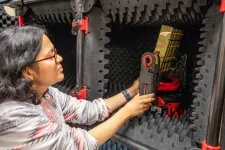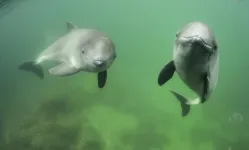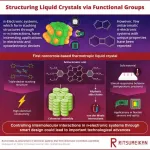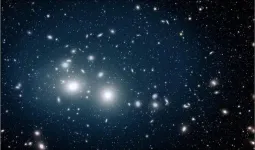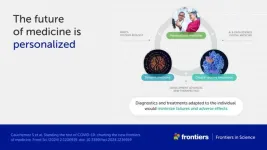(Press-News.org) Both literally and figuratively, light pervades the world. It banishes darkness, conveys telecommunications signals between continents and makes visible the invisible, from faraway galaxies to the smallest bacterium. Light can also help heat the plasma within ring-shaped devices known as tokamaks as scientists worldwide strive to harness the fusion process to generate green electricity.
Now, scientists have made discoveries about light particles known as photons that could aid the quest for fusion energy. By performing a series of mathematical calculations, the researchers found that one of a photon’s basic properties is topological, meaning that it doesn’t change even as the photon moves through different materials and environments.
This property is polarization, the direction — left or right — that electric fields take as they move around a photon. Because of basic physical laws, a photon’s polarization helps determine the direction the photon travels and limits its movement. Therefore, a beam of light made up of only photons with one type of polarization cannot spread into every part of a given space. These findings demonstrate the Princeton Plasma Physics Laboratory’s (PPPL) strengths in theoretical physics and fusion research.
“Having a more accurate understanding of the fundamental nature of photons could lead to scientists designing better light beams for heating and measuring plasma,” said Hong Qin, a principal research physicist at the U.S. Department of Energy’s (DOE) PPPL and co-author of a paper reporting the results in Physical Review D.
Simplifying a complicated problem
Though the researchers were studying individual photons, they were doing so as a way to solve a larger, more difficult problem — how to use beams of intense light to excite long-lasting perturbations in the plasma that could help maintain the high temperatures needed for fusion.
Known as topological waves, these wiggles often occur on the border of two different regions, like plasma and the vacuum in tokamaks at its outer edge. They are not especially exotic — they occur naturally in Earth’s atmosphere, where they help produce El Niño, a gathering of warm water in the Pacific Ocean that affects weather in North and South America. To produce these waves in plasma, scientists must have a greater understanding of light — specifically, the same sort of radio-frequency wave used in microwave ovens — which physicists already use to heat plasma. With greater understanding comes the greater possibility of control.
“We are trying to find similar waves for fusion,” said Qin. “They are not easily stopped, so if we could create them in plasma, we could increase the efficiency of plasma heating and help create the conditions for fusion.” The technique resembles ringing a bell. Just as using a hammer to hit a bell causes the metal to move in such a way that it creates sound, the scientists want to strike plasma with light so it wiggles in a certain way to create sustained heat.
Solving a problem by simplifying it happens throughout science. “If you’re learning to play a song on the piano, you don’t start by trying to play the whole song at full speed,” said Eric Palmerduca, a graduate student in the Princeton Program in Plasma Physics, which is based at PPPL, and lead author of the paper. “You start playing it at a slower tempo; you break it into small parts; maybe you learn each hand separately. We do this all the time in science — breaking a bigger problem up into smaller problems, solving them one or two at a time, and then putting them back together to solve the big problem.”
Turn, turn, turn
In addition to discovering that a photon’s polarization is topological, the scientists found that the spinning motion of photons could not be separated into internal and external components. Think of Earth: It both spins on its axis, producing day and night, and orbits the sun, producing the seasons. These two types of motion typically do not affect each other; for instance, Earth’s rotation around its axis does not depend on its revolution around the sun. In fact, the turning motion of all objects with mass can be separated this way.
But scientists have not been so sure about particles like photons, which do not have mass. “Most experimentalists assume that the angular momentum of light can be split into spin and orbital angular momentum,” said Palmerduca. “However, among theorists, there has been a long debate about the correct way to do this splitting or whether it is even possible to do this splitting. Our work helps settle this debate, showing that the angular momentum of photons cannot be split into spin and orbital components.”
Moreover, Palmerduca and Qin established that the two movement components can’t be split because of a photon’s topological, unchanging properties, like its polarization. This novel finding has implications for the laboratory. “These results mean that we need a better theoretical explanation of what is going on in our experiments,” Palmerduca said.
All of these findings about photons give the researchers a clearer picture of how light behaves. With a greater understanding of light beams, they hope to figure out how to create topological waves that could be helpful for fusion research.
Insights for theoretical physics
Palmerduca notes that the photon findings demonstrate PPPL’s strengths in theoretical physics. The findings relate to a mathematical result known as the Hairy Ball Theorem. “The theorem states that if you have a ball covered with hairs, you can’t comb all the hairs flat without creating a cowlick somewhere on the ball. Physicists thought this implied that you could not have a light source that sends photons in all directions at the same time,” Palmerduca said. He and Qin found, however, that this is not correct because the theorem does not take into account, mathematically, that photon electric fields can rotate.
The findings also amend research by former Princeton University Professor of Physics Eugene Wigner, who Palmerduca described as one of the most important theoretical physicists of the 20th century. Wigner realized that using principles derived from Albert Einstein’s theory of relativity, he could describe all the possible elementary particles in the universe, even those that hadn’t been discovered yet. But while his classification system is accurate for particles with mass, it produces inaccurate results for massless particles, like photons. “Qin and I showed that using topology,” Palmerduca said, “we can modify Wigner’s classification for massless particles, giving a description of photons that works in all directions at the same time.”
A clearer understanding for the future
In future research, Qin and Palmerduca plan to explore how to create beneficial topological waves that heat plasma without making unhelpful varieties that siphon the heat away. “Some deleterious topological waves can be excited unintentionally, and we want to understand them so that they can be removed from the system,” Qin said. “In this sense, topological waves are like new breeds of insects. Some are beneficial for the garden, and some of them are pests.”
Meanwhile, they are excited about the current findings. “We have a clearer theoretical understanding of the photons that could help excite topological waves,” Qin said. “Now it’s time to build something so we can use them in the quest for fusion energy.”
This research was funded by the DOE award DE-AC02-09CH11466.
PPPL is mastering the art of using plasma — the fourth state of matter — to solve some of the world's toughest science and technology challenges. Nestled on Princeton University’s Forrestal Campus in Plainsboro, New Jersey, our research ignites innovation in a range of applications, including fusion energy, nanoscale fabrication, quantum materials and devices, and sustainability science. The University manages the Laboratory for the U.S. Department of Energy’s Office of Science, which is the nation’s single largest supporter of basic research in the physical sciences. Feel the heat at https://energy.gov/science and http://www.pppl.gov.
END
New discoveries about the nature of light could improve methods for heating fusion plasma
2024-05-23
ELSE PRESS RELEASES FROM THIS DATE:
Lehigh University researchers explore innovative cable-based approach to aerial robotics
2024-05-23
When we think about drones, we tend to think about Amazon. But their potential is much greater, and arguably far more important, than dropping off a box of laundry pods by lunchtime (an idea that’s struggled to take off since Jeff Bezos floated it more than a decade ago).
Aerial robots could be a huge asset, saving time, money, and workers’ well-being, in industries like construction where humans often have to heft materials up multiple floors, says David Saldaña, an assistant professor of computer science and engineering. They could also deliver ...
Researcher charges ahead with new tech to power drones wirelessly
2024-05-23
Dr. Ifana Mahbub, assistant professor of electrical and computer engineering at The University of Texas at Dallas, has been awarded the Defense Advanced Research Projects Agency (DARPA) Director’s Fellowship to continue her research to develop wireless technology to recharge unmanned aerial vehicles (UAVs) in flight.
DARPA awards the fellowships to its Young Faculty Award recipients who demonstrate exceptional performance. Mahbub received a Young Faculty Award, which provided $500,000 over ...
Features of bloodstream infection among immunocompromised oncology patients presenting to the emergency department with fever
2024-05-23
Background and Aims
Oncology patients undergoing cancer treatment and experiencing episodes of fever are known to be at increased risk for invasive bacterial infection, including bloodstream infection. This study aimed to identify the incidence of bacteremia along with the bloodstream isolates for immunocompromised oncology patients referred to the emergency department (ED) due to fever.
Methods
Oncology patients with fever were referred to the ED according to a protocol previously reported. Virtually ...
How family economic insecurity can hurt child mental health
2024-05-23
COLUMBUS, Ohio – Economic difficulty caused by the COVID-19 pandemic led to a cascade of connected problems for some parents – resulting in mental health problems for their children, a new study suggests.
Researchers found that economic insecurity was linked to higher levels of depressive symptoms for parents, which was then associated with poorer relationship quality for the couples. That was linked with more harsh parenting and then to increased internalizing behaviors for their children.
“Pandemic-induced ...
Constantly on the hunt for food: Harbor porpoises more vulnerable than previously thought to the disturbances from humans
2024-05-23
Summer is coming and that means more boats in the sea. Danish coastal waters are especially cluttered with small boats in the summertime. Locals water skiing, going fishing or just riding around the beautiful bays and fjords.
In general people relax and have a good time on the water, but that is unfortunately not the case for the harbor porpoise.
The more motor boats speeding noisily around, the more they are disturbed. And that can be a big problem for the animals.
Because the harbor porpoise is a relatively large animal that feeds on small fish it needs to spend a lot of time hunting. New research shows that it spends around 60 percent of its time on the hunt, but ...
Producing novel liquid crystals by stacking antiaromatic units
2024-05-23
In organic chemistry, π-stacking systems are supramolecular structures that arise due to the dispersion force, a type of intermolecular noncovalent interaction. They are a common occurrence in nature; the stabilized structure of DNA is a very prominent example of a π-stacking system, and so are the arrangement of amino acids in certain proteins. Interestingly, π-stacking can be leveraged in the design of materials with useful electronic and optical properties. These include organic semiconductors of various kinds, as well as conjugated polymers for sensing and biomedical applications.
Thus far, a good portion of technologically relevant π-stacking system has been limited ...
First pictures from Euclid satellite reveal billions of orphan stars
2024-05-23
The first scientific pictures from the Euclid satellite mission have revealed more than 1,500 billion orphan stars scattered throughout the Perseus cluster of galaxies.
Led by astronomers from the University of Nottingham, this discovery sheds light on the origins of these celestial wanderers.
The Perseus cluster, located 240 million light-years away from Earth, is one of the Universe's most massive structures, boasting thousands of galaxies. However, amidst this cosmic ensemble, the Euclid satellite captured faint ghostly light - the orphan stars - drifting between the cluster's galaxies.
Stars naturally form within galaxies, so the presence of orphan ...
VIDEO: Surrey astrophysicists explore new galaxies and streams of stars using new data from Euclid space telescope
2024-05-23
As the European Space Agency publishes the first findings from its Euclid space telescope, scientists from the University of Surrey are celebrating fresh insights from the data.
Dr Denis Erkal, Associate Professor of Astrophysics at the University of Surrey, studies how the gravity of the Milky Way pulls clusters of stars apart, creating streams of stars trailing across the galaxy.
Now, his model for how this happens (video HERE) has been confirmed by data from Euclid.
Dr Erkal said:
“For a long time, my modelling ...
Scientists reveal first data from Euclid telescope offering snapshot of cosmic history
2024-05-23
Scientists have released the first set of scientific data captured with the Euclid telescope, showing an exciting glimpse of the Universe’s distant past.
The telescope, launched in July 2023, is part of the Dark Energy Satellite Mission, which aims to map the dark Universe.
Led by the European Space Agency in collaboration with The Euclid Consortium - which includes astronomers at The University of Manchester in leadership positions – the mission seeks to unlock mysteries of dark matter and dark energy and reveal how and why the Universe looks as it does today.
Early observations, described in a series ...
Big data, AI, and personalized medicine: scientists reveal playbook aiming to revolutionize healthcare
2024-05-23
What should the medicine of the future look like? A team of scientists writing in Frontiers in Science lays out a bold vision for precision approaches to understanding, preventing, and treating diseases, driven by revolutionary technologies and new interdisciplinary collaborations between researchers and other health sector professionals. The internationally renowned authors – led by Prof Michel Goldman, recipient of the Blaise Pascal Medal 2024 for his exceptional contributions to immunology and healthcare innovation, and leading microbiologist Prof Philippe Sansonetti from the Institut Pasteur and Collège ...

